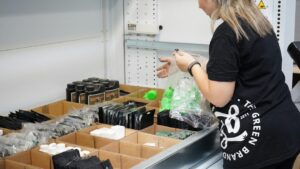The success of your B2B or B2C business heavily relies on the efficiency of your fulfillment operations.
With two out of three global shoppers expecting to receive their purchased goods within 24 hours, speeding up your delivery times will directly impact your customers’ experience and, by extension, your bottom line. That’s where a carrier facility comes in handy.
But what is a carrier facility?
An indispensable part of a supply chain ecosystem, a carrier facility is a physical location that serves as a central hub for sorting and processing packages. Once your carrier picks up a package for shipping, it’s taken to a carrier facility. Here, workers scan and sort it based on several factors. They then load it onto a delivery truck for dispatch or store it for a bit before it proceeds to its next leg in the fulfillment journey and delivery process.
Almost every package passes through a carrier facility, even if it’s just for a few hours. Dive in to learn exactly how a carrier facility operates and its role in the eCommerce fulfillment process.
What Are the Types of Carrier Facilities?
Now that you understand what a carrier facility is, let’s explore the different types of buildings involved and their roles:
- Warehouses: Think of this as a temporary holding area where packages are kept before proceeding to the next stage in their eCommerce fulfillment journey. In other words, it’s a facility that handles inventory storage. Modern warehouses feature cutting-edge technology, such as dark rooms, refrigerators, and climate controls, to ensure goods remain in the best possible condition.
- Distribution Centers: A distribution center ensures packages go to the right place at the right time. Usually equipped to handle a large volume of packages, these locations see a lot of quick product movement — from receiving packages from the warehouse to holding them temporarily to managing them, before they proceed to the next stage.
- Sorting Facilities: These facilities are responsible for separating and consolidating packages based on their final stop. Automated systems can enhance their accuracy and efficiency, resulting in faster package handling and processing. Modern sorting facilities feature tech like barcode scanners, conveyor belts, and label printers that reduce human input and minimize errors.
- Last Mile Delivery Hubs: The final node in a carrier facility, last-mile delivery hubs facilitate the collection of packages before they move to their final destination or pickup point. Delivery drivers pick orders from these hubs and deliver them to a local courier facility or the delivery address.
What Are the Stages of Package Processing?
When a package reaches a carrier facility, it passes through several stages before heading to the next or final destination.
Order Intake
Once packages arrive at a carrier facility after a delivery truck picks them up from a secure drop-off, the order intake process begins. This usually involves inspecting the condition of the package, verifying its contents, and completing relevant paperwork, such as the bill of lading — an important document that outlines general shipment information.
This stage may also include scanning tracking bar codes, which automatically updates the customer and seller that the order has arrived at the carrier facility.
Sorting and Segregation
After the order is received and the necessary paperwork is completed, the packages are then sorted and grouped based on the destination, route, or mode of delivery. From there, some orders will be sent to a warehouse for temporary storage, while others may proceed to the next leg in their journey immediately.
Package Handling and Processing
Next, workers in the carrier facility prepare, sort, and, in some cases, repackage the orders before moving them to the next step in their fulfillment journey. This step can also involve tagging special orders, verifying addresses and weight classes, and flagging exceptions or errors.
Temporary Storage
For more efficient delivery, some orders may be held for a time in temporary storage areas, usually equipped with racks, shelves, and climate controls. Storage can be for as little as a few hours to as much as several days, depending on the destination, shipping priority, or number of orders the carrier facility must process.
Dispatch and Delivery
Eventually, all orders are loaded onto delivery trucks for dispatch and delivery to customers. When in transit, the customer receives a notification to reflect their package has successfully left the carrier facility.
Some packages, often those moving between regions, may be dispatched to a smaller local courier facility or post office for the last-mile delivery, whether that’s to the customer’s doorstep or preferred pickup point.
The Importance of Carrier Facilities
Handling deliveries in-house can quickly run up operational costs. That’s because you have to factor in staffing, infrastructure, and technology costs.
A carrier facility provides an efficient way to keep delivery costs low without the hassle of managing everything yourself. It offers better resource utilization and minimizes waste by optimizing routes, allowing more streamlined and environmentally friendly workflows.
On top of that, customers nowadays expect their orders to be delivered more quickly than ever. Working with a well-run carrier facility, fitted with the latest supply chain technology, means faster deliveries and few to no mistakes. Whether there’s a market change or a seasonal rush, such innovations cut transit times, minimize errors, and deliver the convenience modern shoppers demand.
Technological Advancements in Carrier Facilities
Modern carrier facilities leverage advanced technologies to achieve greater flexibility and efficiency. Here are the top technological innovations that have transformed the package processes at these facilities.
Real-Time Tracking Systems
Gone are the days when customers and business owners needed to make frequent calls to the delivery service to ensure their package was en route. Far more advanced than handwritten logs and physical checkpoints, real-time tracking systems, via cloud computing, RFID, and GPS, allow customers to see exactly which stage their order is in within the supply chain.
In carrier facilities, these systems facilitate seamless inventory management, ensuring all packages are in good condition and at the right place. They also show the best places to store packages before dispatch and delivery.
With the help of RFID scans and barcodes, carrier facilities can automate sorting and picking, reducing the possibility of errors while also synchronizing workflows across various stages of the eCommerce fulfillment journey.
Robust real-time tracking systems come with a simple-to-use dashboard, making it easy to monitor how packages are moving within the facility. Real-time storage updates facilitate a smoother and more efficient warehouse management process.
Enhanced Processing Capabilities
Technological advancements such as high-performance hardware and edge computing help the modern shipping company and carrier facility collect and analyze massive data volumes more quickly and intelligently than ever before. In turn, these facilities can more easily adapt to shifting patterns, optimize operations, and address potential failures, whether in the equipment used or processes involved.
An example of this is how carrier facilities integrate Internet of Things (IoT) solutions for more visibility and streamlined operations. From tracking packages in a warehouse to managing the sort-and-segregate stage and routing, these devices collect real-time data for analysis to reduce downtime, automate routine tasks, and unlock data-driven insights.
Automation and Robotics
Thanks to automation and robotics, many processes within a fulfillment center, such as warehouse management, have become highly efficient and scalable functions. For example, sorting and storage systems now use advanced conveyor belts and automated storage and retrieval systems (AS/RS) to handle packages with speed and next-level accuracy. These systems can scan, sort, and route parcels in real-time based on destination, size, or priority, significantly reducing manual labor and potential mistakes.
Likewise, modern storage operations use robotic shuttles and stacker cranes. These retrieve and organize inventory with minimal human intervention to maximize space utilization and efficient operations, even when dealing with high volumes.
Challenges Faced by Carrier Facilities
Although technological advancements have made carrier facilities more efficient, they still face a number of challenges.
Capacity Management
During sales events, holidays, and other peak seasons, managing inventory and processing orders can become a big challenge due to the high volume of orders. If the facility is handling too many packages, it can create a backlog, resulting in delivery delays and a drop in customer satisfaction.
On the other hand, some facilities invest in too much labor or storage facilities, which can result in unnecessary costs, especially when demand is low.
Operational Efficiency
Even with automation, robotics, enhanced processing capabilities, and real-time tracking systems, many carrier facilities still deal with bottlenecks. These could be in the form of misplaced inventory, inaccurate sorting or order picking, or inefficient inventory management. Such minor issues can quickly add up, affecting delivery timelines and overall customer satisfaction.
Security Concerns
Carrier facilities deal with both sensitive customer information as well as valuable goods. As such, theft, tampering with goods, and unauthorized access have always been a concern.
On the digital side, with ever-increasing cases of cyberattacks worldwide, there is a greater risk of data breaches, system outages, and unauthorized access to order management and tracking systems. Such attacks can compromise customer information, disrupt carrier facility operations, and damage a company’s reputation.
Carrier Facilities: The Backbone of Efficient Order Fulfillment
A carrier facility is a busy pit stop in the supply chain where packages are stored, sorted, and delivered to their intended destination. It supports the smooth transportation of orders from sellers to consumers by improving supply chain visibility, providing efficiency, and transparency in the delivery process.
As a B2B or B2C business owner, you cannot directly control much of what happens in these facilities. That’s why you need an efficient, reliable carrier facility with a proven track record in your corner. The right partnership ensures your customers get the best delivery experience possible, not to mention enhances your business operations with increased shipping accuracy, better tracking, and fewer mistakes and delays.
Achieve Faster Delivery Times With AMS Fulfillment
Give your eCommerce business a much-needed edge by partnering with a high-value, high-capacity order fulfillment company. At AMS Fulfillment, we streamline the entire shipping process, from order picking and intake to sorting, handling, storage, and finally, dispatch and delivery. As a full-service order fulfillment company and distribution center with over 20 years of experience, we are passionate about offering the best experience to all our partners.
Our advanced technology, eco-friendly multi-channel fulfillment processes, inventory management, and customizable packaging solutions, among many other services, are equipped to help B2B and B2C businesses operate more efficiently and scale with confidence. We also support smooth order processing, real-time inventory tracking, and fast deliveries to meet rising customer expectations.
Whether managing a large product catalog or handling high order volumes, our flexible solutions can easily adapt to your business needs. Plus, we are a B Corporation and are highly regarded for putting people and our shared Earth before profit.
If you’re looking to partner with a reliable order fulfillment company, contact us today.




